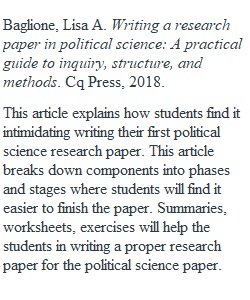


Q Instructions: In the bibliography discussion forum you found academic sources about your topic so that you can conduct a "literature review" i.e. a summary of what scholars already know about your project (the "They Say"). In this step I want you to please summarize each of the sources you listed in your bibliography. To complete this activity post: 1. Original post with your (now) annotated bibliography. 2. Response post to one classmates post in which you help them refine their annotations. ________________________________________ Tips: Each citation should be followed by one to five short sentences about the citation and how it relates to your research question. Remember this is an ANNOTATED BIBLIOGRAPHY. Make sure to comment on other's work as well, let's all help each other produce the best work we can. Your summary of each source should include: • The research question they confronted • The methods of the article • The major finding(s) of the article • Any limitations of the article • Why it is pertinent to your research question/topic *Remember to ALWAYS cite your work! Any acts of plagiarism will result in a 0 for the entire assignment. Please review the Student Code of Conduct (Links to an external site.). ________________________________________ Example: Comiskey, Michael. “The Supreme Court Appointment Process: Lessons from Filling the Rehnquist and O’Connor Vacancies.” Political Science, vol. 41, no. 2, (2008): 355-358. In this article Comiskey uses mixed methods, an engaged historical analysis along with interviews, to analyze Supreme Court appointments from 1980 to 2006. Through this analysis four continuities are identified: "the President predominates, elections matter, quality counts, and nominee testimony provides little that is truly new, but is still valuable." Therefore, my research project should also consider the effects of presidential elections and Senate elections on the ideological leaning of nominees. This is further supported by Comiskey's finding that "Senators are more willing to judge nominees ideologically" (357). Which should, in theory, affect their strategic appointment. In general this article focuses on the likelihood that a nominee with be appointed to the Supreme Court, which is different from my research question about the ideological leaning of those who are appointed. So this is a limitation of this article, however, if the aspects identified in this study affect the likelihood of appointment, strategically and theoretically that should also have a slight influence on the appointment selection process. Eisgruber, Christopher L. The Next Justice: Repairing the Supreme Court Appointment Process. Princeton University Press, 2007. The Supreme Court confirmation process is broken, according to Eisgruber in this vital new text. Through a historical analysis Eisgruber aims to confront potential judges with one question: "When and why is it beneficial for judges to trump the decisions of elected officials?" Through his analysis he argues for a new way to appoint and confirm Supreme Court Justices, arguing that the current system is flawed by party politics. This book really helps me with the research project better understand the history of the appointment process and think critically about the role of party and ideology. Greenberg, David. “The New Politics of Supreme Court Appointments.” Daedalus, vol. 134, no. 3, (2005): 5-12. The appointment process is clearly political. In this article Greenberg makes note that while the Supreme Court process is theoretically supposed to be free of politics and politicking, the growing partisan tensions between the executive and legislative branches in this process have made it clear; politics plays a heavy role. This article has helped me to identify divided government as an important aspect fo the nomination process. According to Greenberg, the rise of identify politics and the culture of scandal are also important to consider. Therefore, I will incorporate all of these aspects into my research. Krehbiel, Keith. “Supreme Court Appointments as a Move-the-Median Game.” American Journal of Political Science, vol. 51, no. 2, (2007): 231-240. This article largely tests a model for the "immediate bearing on policy" of executive appointments to collective bodies, to the Supreme Court over four decades. Through this test, Krehbiel argues finds evidence of support for the "strategic judicial retirements" hypothesis. All in all, he finds that the ideological make-up of the judicial appointments does have an effect upon policy, all be it a small one. The importance of the relationship between the ideological makeup of the court and policy outcomes is at the heart of my inquiry. Krutz, Glen. American Government. 2nd ed., Rice University, 2019. In American Government, Glen Krutz provides an overview of the executive branch in which he states that, "In recent decades, two-term presidents have nominated well over three hundred federal judges while in office" (450). This will help me to better understand the context of roughly how many nominations occur each presidency. In his chapter on the judicial branch, Krutz notes, "Presidential nominees for the courts typically reflect the chief executive’s own ideological position" (502). This is extremely pertinent to my research question, and helps to identify one factor, the ideological position of the US President, that affects the likelihood of a president nominating a moderate. In general this textbook has helped me understand the nomination process, the actors involved, and an indicator for my research. Perry, Barbara A. “Ambition Counteracting Ambition: Separation of Powers in Supreme Court Appointments.” Journal of Supreme Court History, vol. 37, no. 2, (2012): 134-147. In this article, Perry seeks to better understand the influence of sitting judges on the Supreme Court Appointment process. Through a historical analysis of appointments from institution to the 1970s, Perry finds that roughly 1/3 of appointments were influenced by sitting justices. For example, Chief Justice Warren advised both LBJ and JFK in their appointments (144). With the insight of this article I am going to add, the ideological makeup of the current bench to my analysis.
View Related Questions